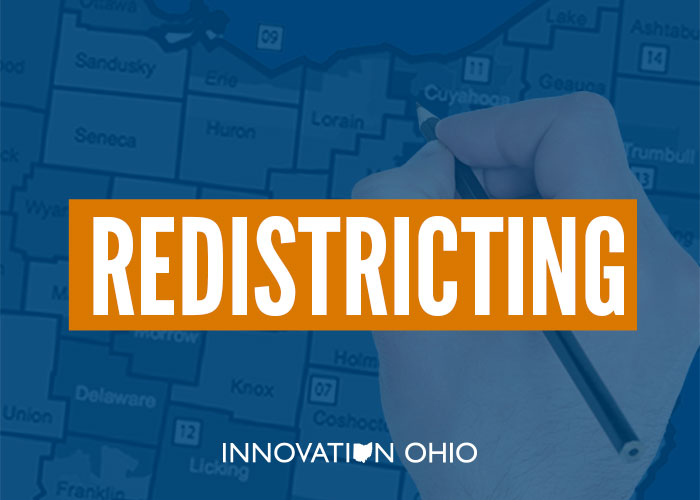What you need to know about Ohio Politics and Policy
Terra Goodnight · February 7, 2018
The bipartisan Congressional redistricting proposal, explained
 On Tuesday, the Ohio House voted 83-10 to pass a proposed amendment to the Ohio Constitution that would, for the first time, require bipartisan input and approval of Ohio congressional maps. The proposal (Senate Joint Resolution 5), which was approved by the Ohio Senate in a 31-0 vote on Monday, will put the question before voters on the May 8, 2018 primary ballot. If approved by voters, the new rules will take effect in the 2022 elections, following the 2021 Census.
A coalition of good-government groups, the NAACP Ohio Chapter, and the citizen-led Fair Districts = Fair Elections petition campaign are supportive of the measure, and have stated publicly that it meets their demands from any congressional redistricting reform proposal, which are the following:
On Tuesday, the Ohio House voted 83-10 to pass a proposed amendment to the Ohio Constitution that would, for the first time, require bipartisan input and approval of Ohio congressional maps. The proposal (Senate Joint Resolution 5), which was approved by the Ohio Senate in a 31-0 vote on Monday, will put the question before voters on the May 8, 2018 primary ballot. If approved by voters, the new rules will take effect in the 2022 elections, following the 2021 Census.
A coalition of good-government groups, the NAACP Ohio Chapter, and the citizen-led Fair Districts = Fair Elections petition campaign are supportive of the measure, and have stated publicly that it meets their demands from any congressional redistricting reform proposal, which are the following:
- Both major parties must be meaningfully engaged in the process.
- Communities should not be needlessly split.
- Rule to prohibit gerrymandering or drawing a congressional map to favor or disfavor one political party.
Here’s how it works:
Stage One: Passage of a map requires a three-fifths vote of both the House and Senate and must include at least 50 percent support of minority party members for adoption of a 10 year map. If agreement isn’t reached, then the bi-partisan Ohio Redistricting Commission is the entity that begins the second phase of the process.
Stage Two: The Ohio Redistricting Commission, an established seven-person bi-partisan commission made up of the Governor, Secretary of State, Auditor of State and two representatives from each chamber of the General Assembly, will be empowered to draw districts and must approve a map with at least two minority party votes. If an agreement isn’t reached for adoption of a 10 year map, then the process moves to Stage 3.
Stage Three: The General Assembly could then adopt a 10-year map with a three-fifths vote of both the House and Senate, including one-third of the minority party’s support. This map would be subject to a Gubernatorial veto and a citizen referendum.
Any map drawn with bipartisan support as noted above would require some limitations on county splits. It would prohibit 65 counties from being split, 18 counties from being split no more than once, and five counties being split no more than twice.
The legislation also requires two public hearings on a proposed map, and allows for public submission of maps for consideration by the map drawing authority. This is significant because it strengthens legal and public relations pressure to further deter partisan tendencies of the map-makers.
Stage Four: If a bipartisan map is not achieved and there is an impasse, a simple legislative majority would draw a temporary map for just four years, and strict map-drawing criteria would apply. These criteria would prevent against unduly splitting counties and drawing maps that favor or disfavor a political party or incumbent. As a further check on this process, this four-year map would be subject to a gubernatorial veto and a citizen referendum. The process starts again as this four-year map expires.
While redistricting reform has been at issue in Ohio for decades, the bi-partisan legislative deal was the recent result of months long negotiation and the past two weeks of non-stop dialogue between legislators and reform advocates. Leveraging the pressure of the Fair Districts = Fair Elections coalition’s efforts to gather over 200,000 signatures, the lead negotiators, made-up of representatives from Common Cause Ohio, the Ohio Environmental Council, Innovation Ohio, League of Women Voters of Ohio, and the NAACP Ohio Chapter worked together closely to reach a deal. Having built a strong table, this close coalition of advocates will stay together to help the Ohio voters understand what is at stake at the ballot box in May to install congressional redistricting reform in Ohio. Coalition partners answered questions from redistricting activists in a live webinar yesterday, a recording of which you can watch online.Tagged in these Policy Areas:


